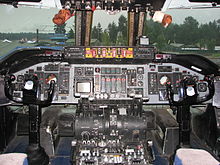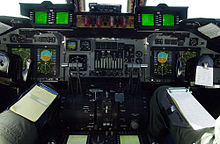Lockheed C-141
| Lockheed C-141 Starlifter | |
|---|---|
 A USAF C-141B-10-LM "Starlifter" |
|
| Type: | Strategic transporter |
| Design country: | |
| Manufacturer: | |
| First flight: |
17th December 1963 |
| Commissioning: |
April 1965 |
| Production time: |
1963 to 1968 |
| Number of pieces: |
285 |

The Lockheed C-141 Starlifter was a military transport plane of the US Air Force (USAF). Developed in the early 1960s, it was in active use for transporting cargo and troops until September 2005.
Development history
In 1960 the USAF decided to procure a jet-powered aircraft for its various transport tasks . It should be able to carry military equipment, cargo pallets or (wounded) soldiers and paratroopers over long distances. So far, propeller-driven Douglas C-124 Globemaster II and Douglas C-133 Cargomaster were usually used for this.
Lockheed emerged victorious from the competition for the contract in March 1961. The successful maiden flight of the C-141A took place on December 17, 1963, the 60th anniversary of the Wright brothers' first powered flight . This made it the first jet aircraft to be developed as a pure transporter. Deliveries began in October 1964 and from April 1965 the first machines were ready for use by the Military Air Transport Service (MATS).
The Starlifter like most military transport as a monoplane constructed with tail in T-shape. The cargo space held either 29 tons of cargo, 155 soldiers, 123 parachutists or 80 stretchers. The cargo could be deposited through the tailgate in flight. There were two side exits at the stern for jumps with the parachute.
modification
The USAF was very pleased with their reliable and versatile freighter; one drawback, however, was that the C-141 could not utilize its maximum payload because the cargo space was too small in relation to it. In the meantime there was the much larger C-5 Galaxy - also built by Lockheed - but it was oversized for many everyday transport tasks. Therefore, between 1977 and 1982, 270 of the still existing C-141A were stretched by 7.1 m by using additional fuselage segments in front of and behind the wings . The hold then had a length of 31.8 m, a width of 3.1 m and a height of 2.7 m. At the same time, the ability for air refueling was upgraded. This C-141B flew for the first time on March 24, 1977 and now had a cargo capacity increased by a third to 42 tons. This increase in performance made the Starlifter the busiest van in the USAF.
Of four specimens originally built for static tests (called NC-141A ), one was converted into the Kuiper Airborne Observatory (KAO) for NASA in May 1973 . For this purpose, a Cassegrain reflector telescope with 91 centimeters opening was installed behind the pilot's cockpit , which was directed upwards through a corresponding cutout in the fuselage roof. The rest of the main deck housed the electronics and operating consoles for the research team. With this flying observatory, NASA observed astronomical objects mainly in the infrared range until 1995 .
In 1994, 13 C-141Bs for the Air Force Special Operations Command were equipped with additional electronics for night operations at low altitudes through the SOLL II program (Special Operations Low Level, in German: Special Operations in Low Level ) . This included infrared sensors, night vision and radar warning devices as well as decoys to distract the enemy air defense.
modernization
From 1997 to 1999, 64 machines were selected for a modernization program that included a digitized pilot's cockpit, GPS and other navigation and defense electronics. Their designation was C-141C. Since the beginning of the 1990s, the new C-17 Globemaster III gradually took over the tasks of the C-141.
Retirement
On September 16, 2004, the Air Mobility Command (AMC) put its last Starlifter out of service. An Air Force Reserve Command (AFRC) C-141C was in its final combat mission of its type on September 26, 2005 when it was evacuating the wounded from Afghanistan. The AFRC's 445th Airlift Wing was the last unit to use this aircraft.
The penultimate Starlifter (registration number: 67-0166) flew to Scott Air Force Base ( Illinois ) on April 7, 2006 , to be exhibited there afterwards. The last flight of a C-141 Starlifter (67-0177, Hanoi Taxi ) was on May 6, 2006 and ended with a celebration at Wright-Patterson Air Force Base . In the USAF Museum there , this machine will then specifically commemorate the return of the US prisoners of war from Vietnam.
Most starlifters after retirement were flown to the 309th Aerospace Maintenance and Regeneration Group (AMARG) in Tucson, Arizona. Due to the fact that the entire fleet of the C-141 Starlifter was decommissioned by 2006 and reactivation is very unlikely (also since many airframes have reached the end of their life expectancy), the scrapping of the aircraft began as early as summer 2003. Due to their size, they are cut into several parts with a guillotine mounted on a crane and transported to surrounding recycling companies.
USAF production
Acceptance of the C-141 by the USAF:
| version | 1963 | 1964 | 1965 | 1966 | 1967 | 1968 | TOTAL |
|---|---|---|---|---|---|---|---|
| C-141A | 4th | 9 | 58 | 102 | 108 | 3 | 284 |
variants
- C-141A: Original model, built from 1963 to 1967, 284 machines.
- NC-141A: test aircraft, four machines.
- C-141B: fuselage stretched 7.1 m, air refueling. Conversion of all 270 C-141A between 1977 and 1982. SOLL II equipment for 13 C-141B 1994.
- C-141C: From 1997 to 1999 modernized C-141B ( cockpit , avionics ), 64 machines.
- KAO ( Kuiper Airborne Observatory ): Flying telescope operated by NASA . A machine based on the NC-141A , in use from 1973 to 1995.
Incidents
From the first flight in 1963 to the end of operations in 2006, the C-141 Starlifter suffered 21 total losses. In 16 of them, 187 people were killed. Examples:
- On September 7, 1966, maintenance technicians on a C-141A Starlifter ( aircraft number 65-0281 ) at McChord Air Force Base shorted a partially depleted fuel tank. In the resulting explosion, three people were killed and the almost brand-new aircraft was destroyed.
- On September 13, 1997 collided with the aircraft collision off Namibia in 1997 a C-141B Starlifter (65-9405) off the coast of Namibia with a flying wrong amount Tupolev Tu-154 (11 + 02) of the Special Air Mission Wing of the Federal Ministry of Defense . All 33 people on board the two machines were killed.
Technical specifications
| Parameter | C-141A | C-141B / C |
|---|---|---|
| crew | 5 (pilot, co-pilot, two flight engineers, one loadmaster) | |
| length | 44.2 m | 51.3 m |
| span | 48.8 m | |
| height | 12.0 m | |
| Wing area | 300 m² | |
| Max. Payload | 28.8 t | 42.5 t |
| Max. Takeoff mass | 143.6 t | 147.0 t |
| Top speed | 919 km / h | 912 km / h |
| Range (with max. Payload) |
6566 km | 4723 km |
| Engines | four Pratt & Whitney TF33-P-7s with 91 kN thrust each | |
Web links
Individual evidence
- ↑ Lockheed C-141 Starlifter . In: AMARC Experience. Retrieved October 29th.
- ↑ Statistical Digest of the USAF 1963, p. 71 f .; 1964, p. 58 f .; 1965, pp. 60 f .; 1966, p. 115 f .; 1967, p. 122 f .; 1968, p. 132 f.
- ↑ Lockheed C-141 Starlifter accident statistics , Aviation Safety Network , accessed on December 11, 2018.
- ↑ accident report C-141A 65-0281 , Aviation Safety Network (English), accessed on 11 December 2018th
- ^ Accident report C-141B 65-9405 , Aviation Safety Network (English), accessed on December 11, 2018.





